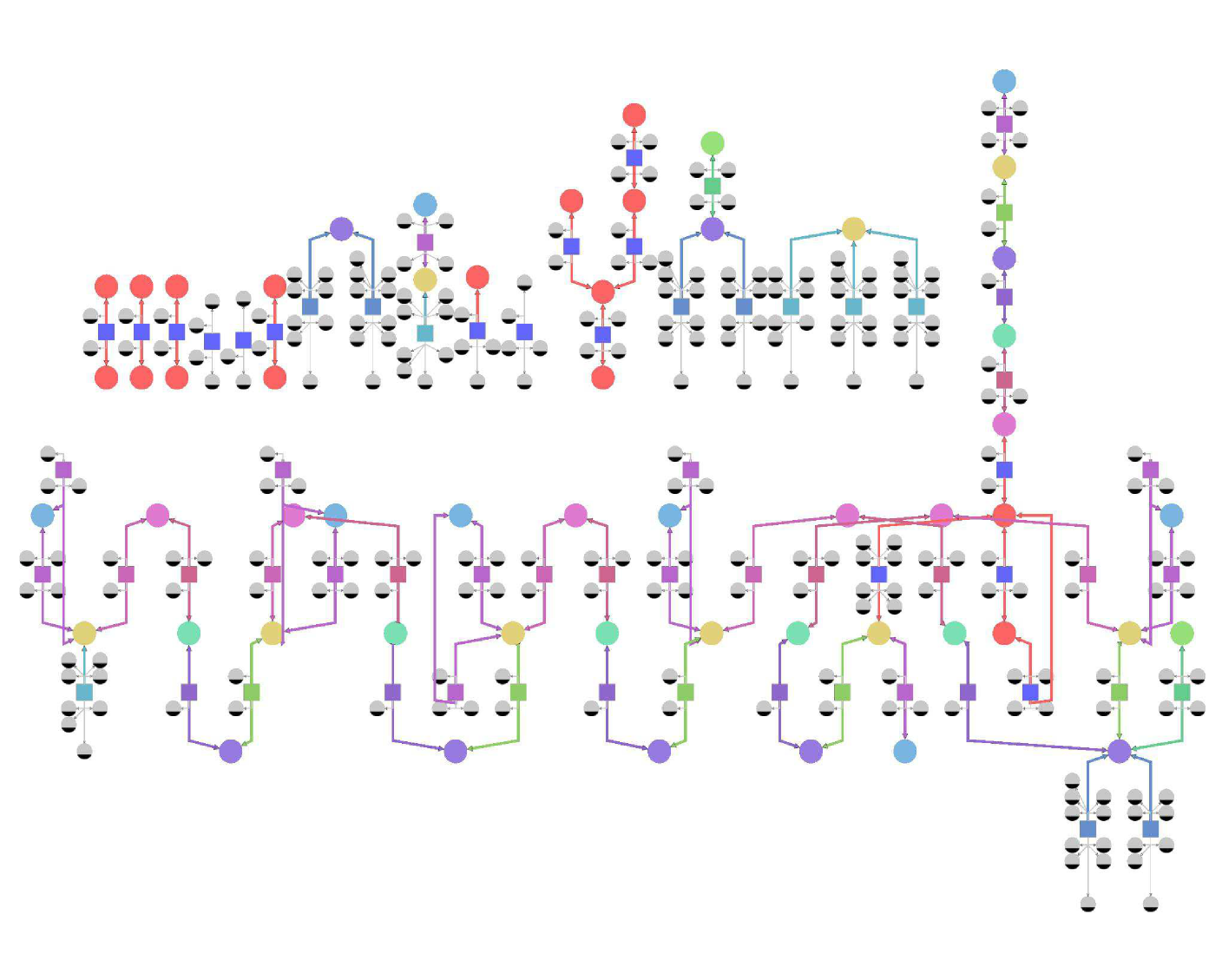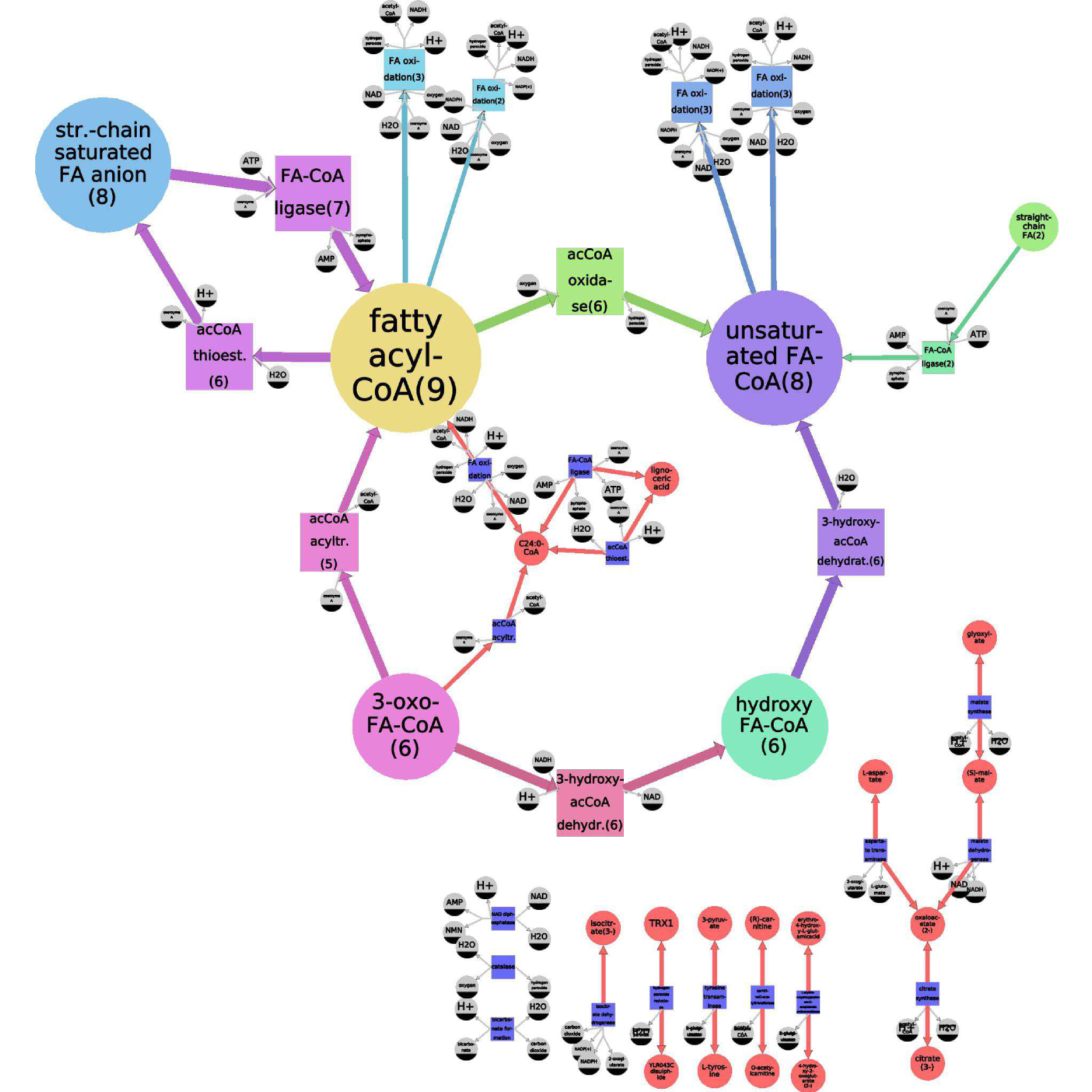Section: New Results
Knowledge-based generalization of metabolic models
Participants : David James Sherman [correspondant] , Pascal Durrens, Razanne Issa, Anna Zhukova.
There is an inherent tension between detail and understandability in large metabolic networks: detailed description of individual reactions is needed for simulation, but high-level views of reactions are needed for describing pathways in human terms. We defined knowledge-based methods that factor similar reactions into “generic” reactions in order to visualize a whole pathway or compartment, while maintaining the underlying model so that the user can later “drill down” to the specific reactions if need be[22] , [23] , [26] This method is available as a Python library from http://metamogen.gforge.inria.fr/ .
Figures 3 and 4 illustrate model generation for Yarrowia lypolitica fatty acid oxidation in the peroxisome. Molecular species are represented as circular nodes, and the reactions as square ones, connected by edges to their reactants and products. Ubiquitous species (e.g. oxygen, water, ATP) are of smaller size and colored gray. Non-ubiquitous species are divided into fifteen equivalence classes and colored accordingly (red/blue for trivial species/reaction equivalence classes, different colors for non-trivial equivalence classes). The size of the model does not allow for readability of the species labels, thus we do not show them (figure 3 ).
The generalization algorithm identifies equivalent molecular species using an ontology, and groups together reactions that operate on the same abstract species. It finds the greatest generalization the preserves stoichiometry. The generalized model represents quotient species and reactions. For example, the violet unsaturated FA-CoA node is a quotient of hexadec-2-enoyl-CoA, oleoyl-CoA, tetradecenoyl-CoA, trans-dec-2-enoyl-CoA, trans-dodec-2-enoyl-CoA, trans-hexacos-2-enoyl-CoA, trans-octadec-2-enoyl-CoA, and trans-tetradec-2-enoyl-CoA (colored violet in figure 3 ). In a similar manner, the light-green acCoA oxidase quotient reaction, that converts fatty acyl-CoA (yellow) into unsaturated FA-CoA (violet), generalizes six corresponding light-green reactions of the initial model (figure 3 ).
The generalized model describes -oxidation in a more generic way: as a transformation of fatty acyl-CoA (yellow) into unsaturated FA-CoA (violet), then into hydroxy FA-CoA (dark green), 3-oxo FA-CoA (magenta), and back to fatty acyl-CoA (with a shorter carbon chain); while the specific model describes the same process in more details, specifying those reactions for each of the fatty acyl-CoA species presented in the organisms' cell (e.g. decanoyl-CoA, dodecanoyl-CoA, etc.). That is why the -oxidation chain of the reactions in the initial model, transforming step-by-step the fatty-acyl-CoA with the longest carbon chain into the one with the shortest chain, in the generalized model appears as a cycle (generalizing all the fatty-acyl-CoAs into one species, regardless the chain-length).
The specific model is appropriate for simulation, because it contains all of the precise reactions. The generalized model is suited for a human, because it reveals the main properties of the model and masks distracting details. For example, the generalized model highlights the fact that there is a particularity concerning C24:0-CoA (stearoyl-CoA) (red, inside the cycle): there exists a "shortcut" reaction (blue, inside the cycle), producing it directly from another fatty acyl-CoA (yellow), avoiding the usual four-reaction beta-oxidation chain, used for other fatty acyl-CoAs. This shortcut is not obvious in the specific model, because it is hidden among a plethora of similar-looking reactions.



